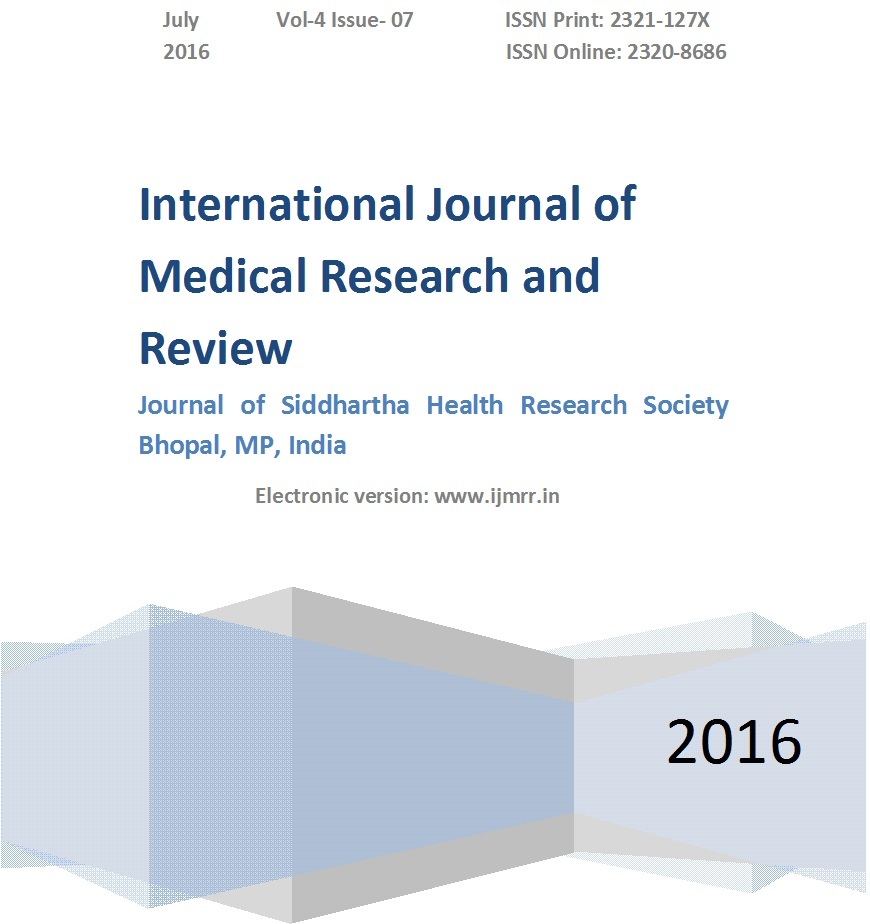Laparoscopic transabdominal preperitoneal versus open mesh lichtenstein repair of inguinal hernia: a comparative analysi
Abstract
Background: Inguinal hernia repair is a commonly performed surgery usually managed by open surgical mesh repair. Nowadays many patients are demanding laparoscopic hernia repair. Laparoscopic hernioplasty has a shorter rehabilitation, but it is a technically difficult procedure. It is unclear if it has advantages over open tension-free mesh repair.
Methodology: This prospective study of 80 patients is done at Jawaharlal Nehru Medical College Hospital, A.M.U., Aligarh from January 2012 to November, 2014. 50 patients underwent Lichtenstein tension free mesh repair while on 30 patients TAPP was performed.
Results: Out of 80 patients 7 patients were lost to follow up at 2 weeks. 47 patients in Lichtenstein group and 26 patients in TAPP group were followed for 6 months. Average operation time was 39.3±16.4 minutes for the Lichtenstein group and 51.4±15.8 minutes for the TAPP group. Postoperatively, pain score was 6.5±3.5 in lichtenstein group as compared to 5.8±1.5 in TAPP group. Because of lesser postoperative pain, the TAPP patients got significantly fewer analgesics than the Lichtenstein patients (2.4 ± 1.0) versus (3.5 ± 1.3) doses. TAPP patients needed significantly fewer admission days than Lichtenstein patients (2.5±0.6 versus 1.8±0.5 days, respectively). TAPP patients returned to work earlier as compared to Lichtenstein group (11.7±4.9 days versus 14.8±4.2 days respectively). Short term and long complications were similar in both groups.
Conclusion: Laparoscopic hernioplasty (TAPP) is superior to Lichtenstein tension-free hernioplasty in terms of postoperative pain, hospital stay and return to daily activity.
Downloads
References
Thorwald J. Bassini. The Triumph of Surgery. 1st ed. Great Britain: Jarold& Sons; 1960. p.274-299.
Javid PJ, Brooks DC. Hernias. In: Zinner MJ, Ashley SW, editors. Maingot'sAbdominalOperations. 11th ed.USA: The McGraw-Hill Companies, Inc.; 2007. p. 103.
Fitzgibbons RJ, Filipi CJ, Quinn TH. Inguinal Hernias. In: Brunicardi FC, Andersen DK, BilliarTR, Dunn DL, Hunter JG, Pollock RE, editors. Schwartz’s Principles of Surgery. 8th ed. USA:The McGraw-Hill Companies, Inc.; 2005. p. 1354.
Kingsnorth AN, Britton BJ, Morris PJ. Recurrent inguinal hernia after local anaesthetic repair. Br J Surg. 1981 Apr;68(4):273-5.doi: https://doi.org/10.1002/bjs.1800680416.
Scott NW, McCormack K, Graham P, Go PM, Ross SJ, Grant AM. Open mesh versus non-mesh for repair of femoral and inguinal hernia. Cochrane Database Syst Rev. 2002;(4):CD002197.doi:https://doi.org/10.1002/14651858.cd002197.
Ger R. The management of certain abdominal herniae by intra-abdominal closure of the neck of the sac. Preliminary communication. Ann R Coll Surg Engl. 1982 Sep;64(5):342-4.
McCormack K, Scott NW, Go PM, Ross S, Grant AM; EU Hernia Trialists Collaboration. Laparoscopic techniques versus open techniques for inguinal hernia repair. Cochrane Database Syst Rev. 2003;(1):CD001785.doi: https://doi.org/10.1002/14651858.cd001785.
Sherwinter DA, Lavotshkin S. Hernia inguinal repair, open: treatment & medication. eMedicine. Updated 2009 Jul 24. http://emedicine.medscape.com/article/1534281-treatment. Accessed January 26, 2011.
Dripps RD. New classification of physical status. Anesthesiol. 1963;24:111.
Lichtenstein IL, Shulman AG, Amid PK, Montllor MM. The tension-free hernioplasty. Am J Surg. 1989 Feb;157(2):188-93.doi: https://doi.org/10.1016/0002-9610(89)90526-6.
Hope WW, Bools L, Menon A, Scott CM 3rd, Adams A, Hooks WB 3rd. Comparing laparoscopic and open inguinal hernia repair in octogenarians. Hernia. 2013 Dec;17(6):719-22. doi: https://doi.org/10.1007/s10029-012-1013-3. Epub 2012 Nov 7.
Symeonidis D, Baloyiannis I, Koukoulis G, Pratsas K, Georgopoulou S, Efthymiou M, Tzovaras G. Prospective non-randomized comparison of open versus laparoscopic transabdominalpreperitoneal (TAPP) inguinal hernia repair under different anesthetic methods.Surg Today. 2014 May;44(5):906-13. doi: https://doi.org/10.1007/s00595-013-0805-0. Epub 2013 Dec 7.
Perko Z, Rakic M, Pogorelic Z, Družijanic N, Kraljevic J. Laparoscopic transabdominal preperitoneal approach for inguinal hernia repair: a five-year experience at a single center. Surg Today 2011 Feb;41(2): 216-221. DOI: https://doi.org/10.1007/s00595-010-4266-4.
Tzovaras G, Symeonidis D, Koukoulis G, Baloyiannis I, Georgopoulou S, Pratsas C, Zacharoulis D. Long-term results after laparoscopic transabdominal preperitoneal (TAPP) inguinal hernia repair under spinal anesthesia. Hernia. 2012 Dec;16(6):641-5. doi: https://doi.org/10.1007/s10029-012-0934-1. Epub 2012 Jun 24.
Eklund AS, Montgomery AK, Rasmussen IC, Sandbue RP, Bergkvist LA, Rudberg CR. Low recurrence rate after laparoscopic (TEP) and open (Lichtenstein) inguinal hernia repair: a randomized, multicenter trial with 5-year follow-up. Ann Surg. 2009 Jan;249(1):33-8. doi: https://doi.org/10.1097/SLA.0b013e31819255d0.
Oguz H, Karagulle E, Turk E1, Moray G. Comparison of peritoneal closure techniques in laparoscopic transabdominal preperitoneal inguinal hernia repair: a prospective randomized study. Hernia. 2015 Dec;19(6):879-85. doi: https://doi.org/10.1007/s10029-015-1431-0. Epub 2015 Oct 20.
Schmedt CG, Sauerland S, Bittner R. Comparison of endoscopic procedures vs Lichtenstein and other open mesh techniques for inguinal hernia repair: a meta-analysis of randomized controlled trials. Surg Endosc. 2005 Feb;19(2):188-99. Epub 2004 Dec 2.doi: https://doi.org/10.1007/s00464-004-9126-0.
Dedemadi G, Sgourakis G, Karaliotas C, Christofides T, Kouraklis G, Karaliotas C. Comparison of laparoscopic and open tension-free repair of recurrent inguinal hernias: a prospective randomized study. Surg Endosc. 2006 Jul;20(7):1099-104. Epub 2006 Jun 8.doi: https://doi.org/10.1007/s00464-005-0621-8.
Eklund A, Rudberg C, Leijonmarck CE, Rasmussen I, Spangen L, Wickbom G, Wingren U, Montgomery A. Recurrent inguinal hernia: randomized multicenter trial comparing laparoscopic and Lichtenstein repair. Surg Endosc. 2007 Apr;21(4):634-40. Epub 2007 Feb 16.doi: https://doi.org/10.1007/s00464-006-9163-y.
Neumayer L, Giobbie-Hurder A, Jonasson O, Fitzgibbons R Jr, Dunlop D, Gibbs J, Reda D, Henderson W; Veterans Affairs Cooperative Studies Program 456 Investigators. Open mesh versus laparoscopic mesh repair of inguinal hernia. N Engl J Med. 2004 Apr 29;350(18):1819-27. Epub 2004 Apr 25.doi: https://doi.org/10.1056/nejmoa040093.
Demetrashvili Z, Qerqadze V, Kamkamidze G, Topchishvili G, Lagvilava L, Chartholani T, Archvadze V. Comparison of Lichtenstein and laparoscopic transabdominal preperitoneal repair of recurrent inguinal hernias. Int Surg. 2011 Jul-Sep;96(3):233-8.doi: https://doi.org/10.9738/cc53.1.
Jensen P, Mikkelsen T, Kehlet H. Postherniorrhaphy urinary retention--effect of local, regional, and general anesthesia: a review. Reg Anesth Pain Med. 2002 Nov-Dec;27(6):612-7. doi: http://dx.doi.org/10.1053/rapm.2002.37122.
Tamme C, Scheidbach H, Hampe C, Schneider C, Köckerling F. Totally extraperitoneal endoscopic inguinal hernia repair (TEP). Surg Endosc. 2003 Feb;17(2):190-5. Epub 2002 Dec 4. doi: https://doi.org/10.1007/s00464-002-8905-8.
Fitzgibbons RJ Jr, Camps J, Cornet DA, Nguyen NX, Litke BS, Annibali R, Salerno GM. Laparoscopic inguinal herniorrhaphy. Results of a multicenter trial. Ann Surg. 1995 Jan;221(1):3-13.doi: https://doi.org/10.1097/00000658-199501000-00002.
Mir IS, Nafe AA, Malyer AA, Nafe M, watali Y, Farooq M, Bhat SB, Viqar S. An Experience of Short-Term Result of Laparoscopic Inguinal Hernioplasty Using 3D Mesh in a Developing Country. IJCM 2015 Jan;6:64-69.doi http://dx.doi.org/10.4236/ijcm.2015.61010.



 OAI - Open Archives Initiative
OAI - Open Archives Initiative


